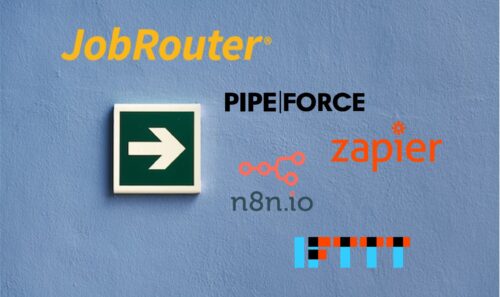
What is a workflow?
In an increasingly globalized world, more and more international technical terms are being integrated into the German language. It is not always easy to maintain an overview here. For this reason, in this article we will first define the term workflow and explain how and why you should record workflows and use their potential.
Definition workflow
A workflow is basically the English translation of the word “workflow”. In everyday language, one often also speaks of a process or business process. By definition, however, a business process is much more like a string of multiple workflows. In most cases, a workflow is characterized by the fact that it is recurring, as well as by the division of labor – i.e. different people are involved in it.
What does such a workflow look like?
According to DIN EN ISO 6385:2004, a work process is the “… spatial and temporal sequence of the interaction of workers/users, work equipment, materials, energy and information within a work system.”. This means that when capturing workflows, the first thing to do is to define different activities of a process (e.g. invoice processing) from start to finish and put them in the right order. Subsequently, these activities are assigned to the responsible persons (e.g. Mr. Meier confirms invoice receipt) and these in turn are given the necessary work equipment, materials or information. If you want to display a workflow, it is best to use software, otherwise it quickly becomes confusing. So that as many people as possible clearly understand the process, so-called notation standards are used to record the process. One of the most common notation standards for a process is the so-called BPMN (= Business Process Model and Notation) Spelling.
Why should I describe a workflow?
Things can often get chaotic in a company. Deadlines are not met and documents are lost. No wonder, because employees often have different areas of responsibility and need to communicate across departments in order to process them. Here you can quickly lose the overview.
This can be remedied by describing workflows. It defines clear responsibilities, necessary information and documents, as well as deadlines and sequences. This provides transparency and clarity for employees, and helps identify potential trouble spots. Furthermore, a one-time clear definition involving all employees avoids knowledge monopolies and thus facilitates, for example, the creation of new knowledge. the training of new employees.
Once the workflow has been described and problem areas identified, it is easier to subsequently optimize the entire process. This can save time, money and above all nerves. Part of a process optimization can be the digitalization or automation of the workflow, also called workflow automation or workflow digitalization. The aim of all this is to accelerate and simplify processes, for example by saving tedious documentation time.
Is it worth documenting a workflow? – Conclusion
In short: Almost always!
Especially in processes with several process steps or several participants, there is a high potential for savings. A clear definition eliminates misunderstandings and increases process quality and speed. Conversely, of course, this means that poorly defined processes pose a business risk. This is where professional help can quickly pay off.
For very simple processes with few participants and few documents or information, a definition is not necessarily required, but can quickly become so due to advancing digitization. In particular, decentralized collaboration in the home office often requires digital processes that require prior definition of the manual process.
Above all, the above-mentioned digitization/automation offers extreme potential for processes in general. Knowing your manual workflows is paramount to digitization, so don’t waste time and find out what your options are!
PIPEFORCE
The Munich-based platform PIPEFORCE is a comprehensive solution for capturing manual workflows and converting them into digital ones, as well as training these workflows. The platform is specifically designed to meet the requirements of medium-sized and large companies and supports the entire process from workflow design to digital implementation through an end-to-end approach. With the unique pipeline approach, the integration of systems and the processing of data and documents is mapped extremely flexibly and simply, so that even technically demanding automations can be implemented within a very short time.






